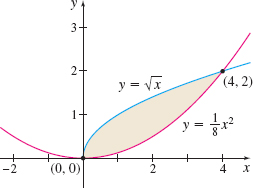EXAMPLE 4Using the Slicing Method to Find the Volume of a Solid
Find the volume V of the solid whose base is the region bounded by the graphs of y=√x and y=18x2, if slices perpendicular to the base along the x-axis have cross sections that are squares.
Solution We begin by graphing the region bounded by the graphs of y=√x and y=18x2, as shown in Figure 43. The points of intersection of the two graphs are found by solving the equation √x=18x2x=164x4x4−64x=0x(x3−64)=0x=0orx=4
The two graphs intersect at the points (0,0) and (4,2).
The solid with slices perpendicular to the base along the x-axis that are squares is shown in Figure 44(a). See Figure 44(b). A slice perpendicular to the x-axis at xi is a square with side si=√xi−18x2i. The area Ai of the cross section at xi is Ai=s2i=(√xi−18x2i)2
437
See Figure 44(c). The volume Vi of a typical slice is Vi=(Area of the cross section)(Thickness of the slice)=A(xi)Δx=(√xi−18x2i)2Δx
The volume V of the solid is V=∫40A(x)dx=∫40(√x−18x2)2dx=∫40(x−14x5/2+164x4)dx=[x22−114x7/2+1320x5]40=8−12814+1024320=7235 cubic units



